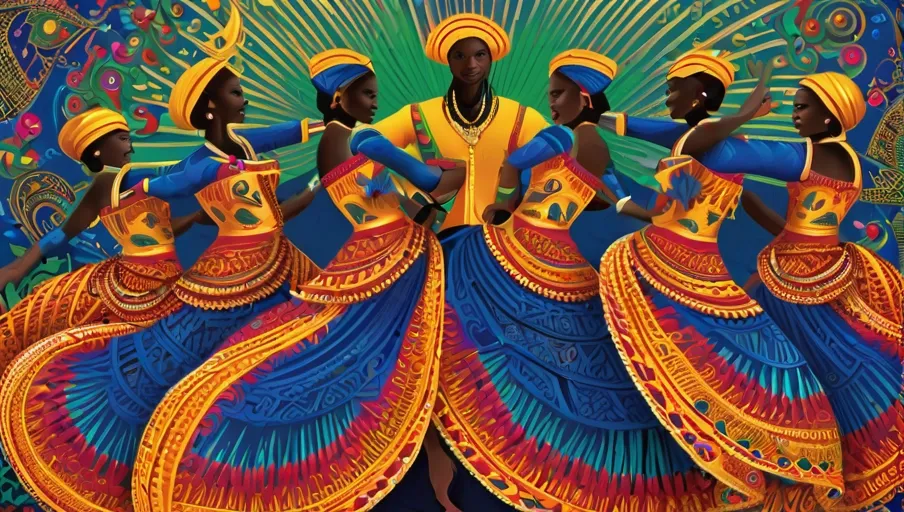
Lansèt Kòd, the vibrant and enigmatic Haitian tradition, has captivated people for centuries. Originating as a form of mockery towards European masters during carnival festivities, it has evolved into a celebration of national pride and independence.
Symbolizing resistance and strength, Lansèt Kòd participants don unique costumes adorned with black paint, embodying the Haitian proverb, ‘We may be ugly, but we are still here.’
This article explores the rituals, symbolism, and history of Lansèt Kòd, offering a unique and meaningful experience to those seeking a deeper understanding of Haitian culture.
- Lansèt Kòd originated from enslaved people in Saint Domingue imitating and mocking their masters’ behavior during European-style carnivals.
- Lansèt Kòd is a celebration of Haitian culture and independence, adopted and infused with Haitian music and culture after Haiti gained independence.
- Lansèt Kòd was created as a form of ridicule towards slave masters, but it is also a symbol of good behavior for children in Haitian culture.
- Lansèt Kòd participants gather in a neighborhood lakou in Jacmel, prepare their costumes, and apply black paint, symbolizing resistance and strength. They bring chaos and disorder to the streets, sprinting and playfully trying to touch others with their black-painted hands.

Lansèt Kòd holds immense cultural significance as a celebration of Haitian culture and independence. It originated from a group of enslaved people in Saint Domingue who used the tradition as a form of ridicule towards their masters during European-style carnivals.
The origins of Lansèt Kòd trace back to an indefinite group of enslaved people in Saint Domingue who, during European-style carnivals, utilized the tradition as a means of imitating and mocking their masters’ behaviors.
Over time, Lansèt Kòd has evolved and adapted, incorporating Haitian music and culture after Haiti gained independence. Today, it symbolizes the resistance and strength of enslaved people.
The tradition involves participants dressing in costumes made from cut-out pants and ragged shorts, applying black paint to their bodies, and playfully trying to touch others with their black-painted hands.
Lansèt Kòd is not only a symbol of pride and resistance but also serves as a reminder of the resilience and endurance of Haitian people.

Exploring the vibrant and chaotic streets of Jacmel during Lansèt Kòd, participants engage in the ritualistic act of blackening their bodies with paint, symbolizing their resistance and solidarity. This unique tradition, deeply rooted in Haitian culture, holds significant symbolism and rituals.
The role of music in Lansèt Kòd is essential, as it sets the rhythm and energy for the participants. Traditional Haitian music, such as rara and konpa, fills the air, creating a lively atmosphere that fuels the celebration.
The black paint used in Lansèt Kòd holds great significance. It represents the strength and resilience of the Haitian people, a visual representation of their resistance against oppression. The black marks symbolize their unwavering solidarity, proclaiming, ‘We may be ugly, but we are still here.’
Through this symbolic act, participants proudly assert their presence and determination to overcome adversity.

The tradition of Lansèt Kòd, with its vibrant costumes and spirited participants, showcases the resilience and unity of the Haitian people in the face of adversity. This unique Haitian carnival tradition holds deep symbolism and rituals that highlight the strength and resistance of the enslaved population.
In Lansèt Kòd, the significance of black paint cannot be overlooked. Participants apply this paint to their bodies, leaving their skin sticky and oily. The black marks symbolize the Haitian proverb ‘Pito nou lèd, nou la’ meaning, ‘We may be ugly, but we are still here.’ It is a powerful statement of pride and defiance.
Additionally, the ocean plays a crucial role in the cleansing ritual of Lansèt Kòd festivities. After a day of chaotic celebrations, participants immerse themselves in the ocean as a symbolic act of renewal and purification. It represents a cleansing of the spirit and a fresh start.
Through these powerful symbols and rituals, Lansèt Kòd serves as a reminder of the strength and resilience of the Haitian people.

Trinidad’s Carnival and Grenada’s Jab-Jab groups both share a concrete tradition with Lansèt Kòd, as participants in these festivals also cover themselves in substances like oil, mud, or grease. This similarity in ritualistic behavior highlights the interconnectedness of Caribbean culture and the enduring impact of African traditions.
To further understand the similarities and differences between Trinidad’s Carnival and Lansèt Kòd, let’s compare them using a table:
| Carnival Tradition | Trinidad’s Carnival | Lansèt Kòd |
|---|---|---|
| Origin | Derived from European-style carnivals | Originated from enslaved people in Saint Domingue |
| Symbolism | Celebration of freedom and cultural expression | Resistance against slavery and oppression |
| Costumes | Elaborate and colorful | Ragged shorts and black paint |
| Main Event | Carnival parade and competitions | Trois Jours Gras parade and rope throwing |
While both celebrations are deeply rooted in history and tradition, they also reflect the unique identities and experiences of their respective cultures. Trinidad’s Carnival showcases the vibrancy and diversity of the Caribbean, while Lansèt Kòd serves as a powerful symbol of Haitian resilience and resistance.
These traditions not only provide a platform for cultural expression but also contribute to the preservation and celebration of Caribbean identity.

Symbolizing resilience and defiance, Lansèt Kòd is a unique carnival tradition in Haiti that showcases the strength of enslaved people. This vibrant celebration has had a significant impact on contemporary Haitian culture and has evolved and modernized over the years.
- Impact on contemporary Haitian culture: Lansèt Kòd is deeply rooted in Haitian history and serves as a powerful symbol of resistance against oppression. It has become an integral part of Haitian identity and is celebrated with great pride and enthusiasm.
- Evolution and modernization of Lansèt Kòd: While the tradition originated as a form of ridicule towards slave masters, it has transformed into a celebration of Haitian culture and independence. Today, Lansèt Kòd has incorporated new elements and performances, embracing modern influences while preserving its historical significance.
Through its evolution and impact, Lansèt Kòd continues to inspire and unite the Haitian people, reminding them of their resilience and determination in the face of adversity.

For a truly immersive experience, consider joining Lansèt Kòd and delving into the quirky and symbolic world of this Haitian carnival tradition.
One of the significant aspects of Lansèt Kòd is the blackening of participants’ bodies with paint. This act holds deep symbolism, representing the resistance and strength of enslaved people.
The black marks serve as a powerful reminder of the Haitian proverb ‘Pito nou lèd, nou la’ meaning, ‘We may be ugly, but we are still here.’
After the day’s festivities, a cleansing ritual takes place in the ocean. This ritual signifies the purification and renewal of the participants, washing away the chaos and disorder brought to the streets of Jacmel.
Exploring this unique tradition offers a quirky and important symbolic experience, fostering joy, camaraderie, and shared excitement among participants.



